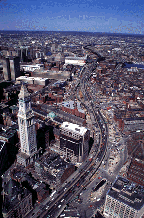Within the past fifty years, the construction of the central artery in the 1950ís,
and the urban renewal movement of the 1960ís, have further exacerbated the dilemna
of connection between neighborhoods. The suburbanization of America and the
subsequent exodus of city inhabitants to periphery towns created the need for
expanded automobile access to and within major cities throughout the United
States. In reaction to this new movement the central artery was constructed
as Boston changed from a city based on its port to a business and financial
center. The central artery was an instrument for this new growth and provided
fluent access to downtown. The highway did lead to new growth and is a neccesity
in our modern society, but at a very large cost. The central artery was a foreign
object cut through the city and further separated many parts of the city. It
created a physical boundary between the harborfront, North End, and downtown.
The highway became the new boundary for the city core, even though throughout
Bostonís history it had always been the waters edge.

